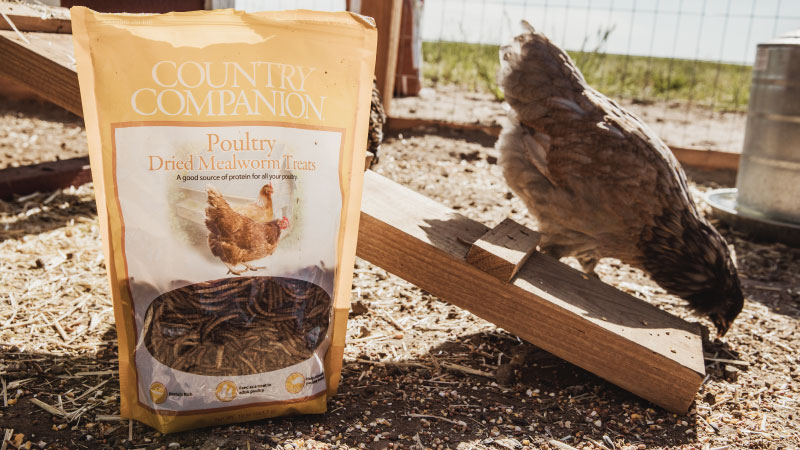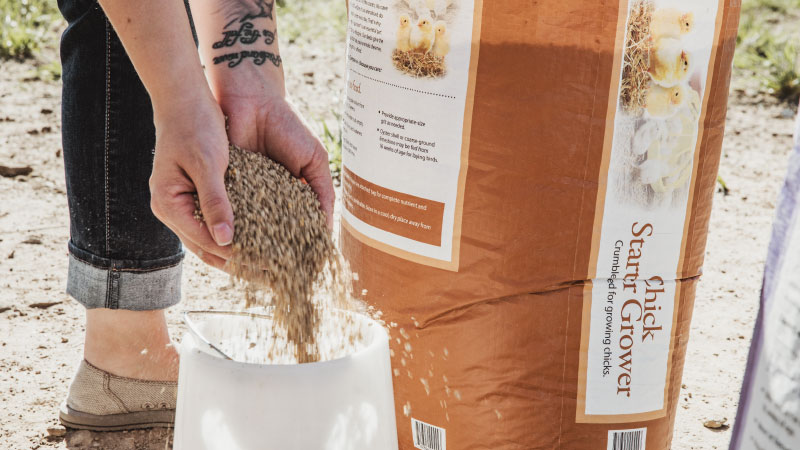What Should I Feed My New Chicks and Chickens?

Contributed by Nutrena Feeds
Poultry are a great addition to any family, and they don’t require too much work. Poultry brings years of entertainment, companionship and, more importantly, eggs. Let’s review the do’s and don’ts of how to feed poultry from furry little friends through mature, cherished hens.
How to Give your Chickens a Strong Start
Chicks from hatch to 16 weeks of age should be fed a diet of solely chick starter, a high-protein feed to support healthy growth of bones and muscles. Chick starters come in medicated or non-medicated varieties, but both are excellent choices. The medication in Nutrena’s medicated chick starter is called Amprolium. Amprolium is not an antibiotic as commonly presumed, but a preventative medication against coccidiosis—the most common reason chicks may die at a young age Chick starter is specially designed to help chicks grow to their best, and should be offered free choice (think all-you-can-eat buffet), along with ample clean water to all chicks from hatch to 16 weeks. At six weeks, you can start to offer treats (but not too much). You should also provide grit if your birds are free range. Grit aids in digestion and helps crush consumed feed inside of the bird’s digestive system.


When will My Chickens Lay their First Eggs?
At 16 weeks, it is time to switch your birds to layer feed. While most growing birds won’t begin laying eggs at 16 weeks, it is important to offer the right nutrition to prepare for egg production. The main differences are a slightly lower protein percentage since birds will be close to full grown, and a higher calcium content. This higher calcium content supports hard eggshells when egg production begins—usually around 20-24 weeks of age, but sometimes sooner. You can choose to feed layer crumbles or pellets, depending on the size and breed of your birds and personal preference. While crumbles encourage consumption, some owners prefer pellets as they yield less waste and can be fed on the ground. You should always provide chickens access to fresh, clean water, as mentioned earlier. You can also give your chickens treats or kitchen scraps, but be sure treats do not exceed 15 percent of the diet. Along with grit, now is a good time to offer free-choice oyster shell supplements, which encourage hard-shelled eggs.


How much Water do My Chicks and Hens Need?
Water consumption is paramount to poultry, just like it is to humans. Plus, daily egg production requires ample water consumption since eggs are about 74 percent water. Depending on the size of your flock, more than one waterer should be available. Flocks naturally create a social hierarchy, resulting in some flock members getting “bullied” away from water should availability be limited.
The most common type of waterer is a font style with a water being refilled by gravity from above. This style is comes in plastic and galvanized models. The plastic versions may come heated for cold climates, but galvanized can easily be placed on a heated base since metal transfers heat more easily. For older birds (greater than 10 weeks), a nipple waterer is an option. Some prefer this style of waterer as they keep the store of water clean. These nipple waterers can take some time for the birds to get used to, but you’ll be amazed after a couple days when most birds figure it out.
Treats for Chickens—Good or Bad?
Giving treats to poultry can be a fun activity, especially when mealworms are involved. Chickens often race to find every last bug on the lawn. However, filling birds up on treats means less room for a complete, wholesome feed. Treats do not have the necessary nutrients to support maximum egg production.
The key to feeding chickens treats is to always keep the amount to what they can eat in about 15 minutes. This way you aren’t feeding too much and can still be a hero to your flock. It’s exciting to see them running to you when you bring out fruit and veggies from the kitchen. Feeding treats can really strengthen the bond between you and your flock and can be used as a tool when you need to call them in, if they are free-ranging. After a while, they start to expect treats and you won’t want to go out there empty-handed.
Another great treat for chickens is scratch grains. You can use scratch grains in the same way you would use kitchen scraps. Scratch grains also makes a great lure to get free-range hens back to the coop earlier than dusk. Chickens also enjoy dried mealworms, cooked pasta, melon, berries, yogurt and bread. Try not to pick anything too sugary, or anything that’s too rotten for you to eat, as mold can be toxic to the birds. Also stay away from citrus fruit as they don’t like it. You can even give them scrambled eggs, but just don’t tell them where they came from. They love pumpkin and squash seeds, popcorn and more. On a cold day, cooked oatmeal is a wonderful treat.


What Should I Feed my Free-range Chickens?
Free-ranging birds is one of the most rewarding parts of owning poultry, but doing so comes with its own challenges. Chickens look forward to leaving the coop each morning, and foraging in the lawn for ticks, worms, and even flies. And, as they do so, they also poop—in turn, fertilizing your yard too.
When you have free-range chickens, feeding them differs slightly from those kept in a run. You need to be sure their vitamin, mineral, amino acid and caloric needs are being met with a commercial feed, but they might not want to eat as much of it because their tummies will be full of everything yummy they found in the yard. Keeping this in mind, if you have free-range chickens you might want to switch to a product designed specifically for free-range chickens, or limit the time they are free to forage.


